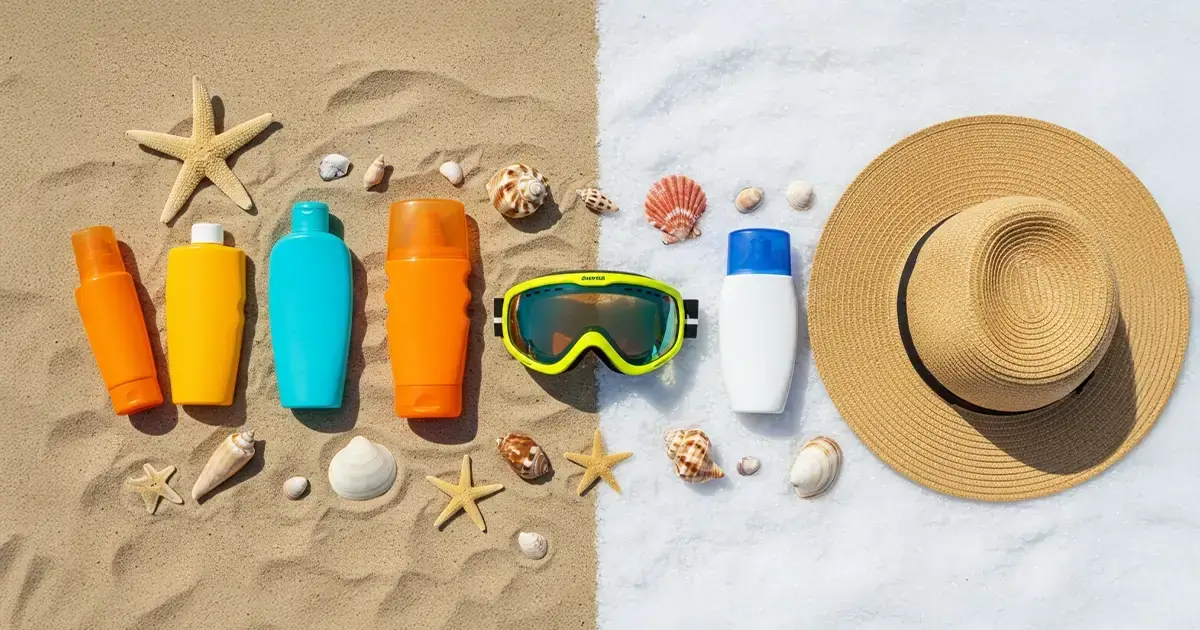Ready to become a sunscreen ninja? In the next few minutes I will demystify broad-spectrum formulas, year-round UV strategies, and easy daily habits that keep every complexion happy, no matter the forecast. Think of it as a sunny master-class in skin safety - about a nine-minute read.
Why Consistent Sun Protection Matters
I know SPF talk can sound repetitive, yet the science stays stubborn: ultraviolet light is the single biggest accelerator of visible skin ageing and certain cancers. A 2022 cross-sectional study published in the Journal of the American Academy of Dermatology found that only 38 percent of adults applied sunscreen "most days," while rates were even lower among deeper skin tones. Translation, we are collectively under-protected, and melanin alone is not an impenetrable force field.
Ultraviolet-B burns, ultraviolet-A sneaks deeper, triggering wrinkles and DNA mutations without the crimson warning flare. Cloud cover only hides about 20 percent of rays, so skipping SPF on grey days feels a bit like leaving your front door wide open because you "don't expect guests." Friends, uninvited photons always show up.
The damage accumulates silently. Collagen strands fray, elastin coils lose spring, and pigment cells fire blotchy SOS signals. By the time those changes appear in the mirror, much of the harm is locked in. That is why dermatologists worldwide preach prevention rather than reversal.
The UV Alphabet, Quickly Decoded
UVA – the "ageing" wavelengths, longer and stealthier, penetrate glass and clouds. They run from sunrise to sundown with little seasonal variation. UVB – the "burning" wavelengths, shorter but more intense, vary with altitude, latitude, and noon peaks. Finally, UVC is thankfully filtered by our atmosphere, so your daily worry list can stay at two letters, not three.
Choosing the Right Sunscreen: Filters, Factors, and Feel
Walk down any pharmacy aisle and you will meet a dizzying lineup: mineral, chemical, hybrid, sticks, sprays, gels, tints. My first rule is simple: pick whatever you will use generously and often. A broad-spectrum badge and a minimum SPF 30 are non-negotiable. The American Academy of Dermatology repeats this mantra in every press release for good reason.
SPF numbers measure UVB - but UVA protection hides behind words. Look for "broad spectrum," "PA+++," or the European UVA circle icon. High SPF without UVA coverage is like locking the front door while leaving the windows wide open.
Mineral filters (zinc oxide, titanium dioxide) sit on top of the skin and scatter rays. They are photostable, safe for sensitive complexions, and now micronised enough to avoid lifeguard-nose whiteness. Chemical filters (avobenzone, octocrylene, Tinosorb S/M) absorb rays and convert them into heat. They feel lighter and are often water-resistant, but some can irritate reactive skin. Hybrid formulas blend both worlds, delivering elegant textures with robust defence.
Texture matters because sloppy application is the silent SPF killer. A Harvard Health explainer notes most people use only 25–50 percent of the amount needed for labelled protection. Think two full fingers of product for the face and neck and a shot-glass (30 ml) for the body. I treat my ears, hairline, and the tops of my feet as VIP zones, never backstage extras.
Water-resistant is vital for beach days, sweaty runs, or toddler wrangling. Remember, "water-resistant 80 minutes" means two dips in the pool can erase most of the shield. Reapply after towel-drying, heavy sweating, or every two hours - whichever comes first. I set a phone alarm because time warps during patio brunch.
Now, here is the fun part… tinted mineral formulas can double as sheer foundation, evening tone and reducing the "flashback" some zinc creams cause in photos. My friends with deeper complexions love these because tonal pigments cancel out any chalky cast.
Reading the Label without a Chemistry Degree
- Active ingredients first: check for zinc oxide ≥ 10 percent or multiple chemical filters.
- Expiry date: ultraviolet filters break down, so toss bottles older than three years or stored in a hot glove box.
- Sensitive skin sign-offs: fragrance-free, alcohol-free, and non-comedogenic badges matter if you battle acne or rosacea.
Smart Habits Beyond the Bottle
Sunscreen is the star, but it loves a strong supporting cast. Wide-brimmed hats block up to 50 percent of direct rays on the face. Category 3 sunglasses protect the delicate eye area and help prevent those involuntary squints that etch crow's-feet. The Mayo Clinic reminds us to chase shade, especially between 10 a.m. and 2 p.m. when UVB peaks.
Lightweight UPF clothing, once relegated to angler shops, is now stylish enough for city strolls. I pack a gauzy UPF 50 button-down for every hike, beach walk, and rooftop yoga session. It weighs less than my water bottle yet covers the shoulders that always burn first.
Remember the reflective culprits: snow, sand, and water bounce extra radiation your way. Skiers can catch serious sunburn on overcast days because ultraviolet rays party on ice crystals. I slather SPF 50 on winter slopes and reapply during cocoa breaks - my gloves stay off long enough for the cream to grip.
Daily SPF also supports hyperpigmentation treatments. Chemical peels, retinoids, and laser sessions all make skin temporarily vulnerable. Skipping sunscreen during those windows undermines every cent spent on brightening serums and in-clinic facials. Protect your investment like you guard your phone screen.
Nutrition and Supplements, Briefly
No pill can replace topical protection, yet antioxidants help counter free radicals sparked by ultraviolet light. Diets rich in colourful produce - think berries, leafy greens, and tomatoes - supply vitamin C, E, and carotenoids. Some dermatologists recommend oral Polypodium leucotomos extract for extra defence in photosensitivity disorders, but consult your physician first.
Myth Busting: Clearing the Hazy Spots
"Darker skin doesn't need sunscreen." Reality, while melanin offers natural SPF of about 13, that falls short of the recommended 30. Pigmented lesions and photo-ageing still occur, and skin cancers can present at later, more dangerous stages.
"SPF 100 blocks twice as much as SPF 50." Not even close. SPF 50 filters about 98 percent of UVB, whereas SPF 100 edges up to roughly 99 percent. The gap is marginal; the key is generous, even application.
"Waterproof sunscreen exists." Marketing magic. Formulas can be water-resistant, but none are truly waterproof or sweatproof. Think of them as temporary umbrellas rather than permanent roofs.
"Sunscreen causes vitamin D deficiency." Practical use rarely does. Harvard researchers explain that most people apply too little to block all UVB, and incidental exposure through windows or brief walks usually suffices to maintain healthy levels. If you are worried, ask your doctor for a blood test before skipping SPF.
FAQ
How much sunscreen should I apply to my face daily?
A simple rule is two stacked fingers of product, about half a teaspoon, spread across face, neck, and ears. This amount ensures you reach the labeled SPF protection.
Do I need sunscreen indoors?
If you sit near windows or spend hours under fluorescent LEDs that emit a small UVA fraction, a light layer is wise. Window glass blocks UVB but lets most UVA glide through.
Is mineral sunscreen better for sensitive skin?
Generally yes, because zinc oxide and titanium dioxide are inert. They do not absorb into skin, so they rarely trigger stinging or allergic reactions common with certain chemical filters.
How often should I reapply during a beach day?
Every two hours, or immediately after swimming, toweling off, or heavy sweating. Even high-SPF formulas thin out with friction and water contact.
Can makeup with SPF replace standalone sunscreen?
Only if you use a full teaspoon of that foundation, which most of us never do. Treat cosmetic SPF as a bonus layer, not your primary shield.
What internal antioxidant helps boost sun defence?
Studies on Polypodium leucotomos extract show moderate photoprotective benefits, but it supplements rather than substitutes topical SPF. Always consult a healthcare professional first.
Conclusion
Consistent, generous sun protection hinges on three pillars: selecting a broad-spectrum SPF 30 or higher you love, practicing smart shade and clothing strategies, and reapplying with clock-like discipline. When these habits team up, they defend every skin tone from silent collagen sabotage and future health scares.
Have more burning questions - or, ideally, no more burns at all? Drop a comment, explore our deep dive on balancing facial pH, and share your favourite SPF hacks. See you in the next post - until then, take good care of your skin!


Comments (0)
No comments yet - be the first to share your thoughts!
Leave a Reply
Your email address will not be published. Required fields are marked *